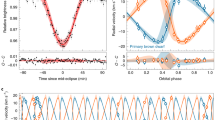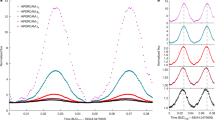Abstract
Interacting compact binary systems provide a natural laboratory in which to study irradiated substellar objects. As the mass-losing secondary (donor) in these systems makes a transition from the stellar to the substellar regime, it is also irradiated by the primary (compact accretor)1,2. The internal and external energy fluxes are both expected to be comparable in these objects, providing access to an unexplored irradiation regime. The atmospheric properties of donors are largely unknown3, but could be modified by the irradiation. To constrain models of donor atmospheres, it is necessary to obtain accurate observational estimates of their physical properties (masses, radii, temperatures and albedos). Here we report the spectroscopic detection and characterization of an irradiated substellar donor in an accreting white-dwarf binary system. Our near-infrared observations allow us to determine a model-independent mass estimate for the donor of 0.055 ± 0.008 solar masses and an average spectral type of L1 ± 1, supporting both theoretical predictions and model-dependent observational constraints that suggest that the donor is a brown dwarf. Our time-resolved data also allow us to estimate the average irradiation-induced temperature difference between the dayside and nightside of the substellar donor (57 kelvin) and the maximum difference between the hottest and coolest parts of its surface (200 kelvin). The observations are well described by a simple geometric reprocessing model with a bolometric (Bond) albedo of less than 0.54 at the 2σ confidence level, consistent with high reprocessing efficiency, but poor lateral heat redistribution in the atmosphere of the brown-dwarf donor4,5. These results add to our knowledge of binary evolution, in that the donor has survived the transition from the stellar to the substellar regime, and of substellar atmospheres, in that we have been able to test a regime in which the irradiation and the internal energy of a brown dwarf are comparable.
This is a preview of subscription content, access via your institution
Access options
Subscribe to this journal
Receive 51 print issues and online access
$199.00 per year
only $3.90 per issue
Buy this article
- Purchase on Springer Link
- Instant access to full article PDF
Prices may be subject to local taxes which are calculated during checkout


Similar content being viewed by others
References
Knigge, C. The donor stars of cataclysmic variables. Mon. Not. R. Astron. Soc. 373, 484–502 (2006)
Knigge, C., Baraffe, I. & Patterson, J. The evolution of cataclysmic variables as revealed by their donor stars. Astrophys. J. Suppl. 194, 28 (2011)
Littlefair, S. P. et al. A J-band detection of the sub-stellar mass donor in SDSS J1433+1011. Mon. Not. R. Astron. Soc. 431, 2820–2825 (2013)
Barman, T. S., Hauschildt, P. H. & Allard, F. Model atmospheres for irradiated stars in precataclysmic variables. Astrophys. J. 614, 338–348 (2004)
Perez-Becker, D. & Showman, A. P. Atmospheric heat redistribution on hot Jupiters. Astrophys. J. 776, 134 (2013)
Vernet, J. et al. X-shooter, the new wide band intermediate resolution spectrograph at the ESO Very Large Telescope. Astron. Astrophys. 536, A105 (2011)
Szkody, P. et al. Cataclysmic variables from Sloan Digital Sky Survey. VI. The sixth year (2005). Astron. J. 134, 185–194 (2007)
Littlefair, S. P. et al. A brown dwarf mass donor in an accreting binary. Science 314, 1578–1580 (2006)
Savoury, C. D. J. et al. Cataclysmic variables below the period gap: mass determinations of 14 eclipsing systems. Mon. Not. R. Astron. Soc. 415, 2025–2041 (2011)
Hubeny, I. & Lanz, T. Non-LTE line-blanketed model atmospheres of hot stars. 1: hybrid complete linearization/accelerated lambda iteration method. Astrophys. J. 439, 875–904 (1995)
Cushing, M. C., Rayner, J. T. & Vacca, W. D. An infrared spectroscopic sequence of M, L, and T dwarfs. Astrophys. J. 623, 1115–1140 (2005)
Burgasser, A. J. et al. Not alone: tracing the origins of very-low-mass stars and brown dwarfs through multiplicity studies. In Protostars and Planets V (eds Reipurth, B. et al.) 427–441 (Univ. Arizona Press, 2007)
Zorotovic, M., Schreiber, M. R. & Gänsicke, B. T. Post common envelope binaries from SDSS. XI. The white dwarf mass distributions of CVs and pre-CVs. Astron. Astrophys. 536, A42 (2011)
Nordhaus, J. & Spiegel, D. S. On the orbits of low-mass companions to white dwarfs and the fates of the known exoplanets. Mon. Not. R. Astron. Soc. 432, 500–505 (2013)
Gänsicke, B. T. et al. SDSS unveils a population of intrinsically faint cataclysmic variables at the minimum orbital period. Mon. Not. R. Astron. Soc. 397, 2170–2188 (2009)
Politano, M. The formation of cataclysmic variables with brown dwarf secondaries. Astrophys. J. 604, 817–826 (2004)
Uthas, H., Knigge, C., Long, K. S., Patterson, J. & Thorstensen, J. The cataclysmic variable SDSS J1507+52: an eclipsing period bouncer in the Galactic halo. Mon. Not. R. Astron. Soc. 414, L85–L89 (2011)
Arras, P. & Bildsten, L. Thermal structure and radius evolution of irradiated gas giant planets. Astrophys. J. 650, 394–407 (2006)
Littlefair, S. P. et al. On the evolutionary status of short-period cataclysmic variables. Mon. Not. R. Astron. Soc. 388, 1582–1594 (2008)
Ritter, H., Zhang, Z.-Y. & Kolb, U. Irradiation and mass transfer in low-mass compact binaries. Astron. Astrophys. 360, 969–990 (2000)
Ruciński, S. M. The proximity effects in close binary systems. II. The bolometric reflection effect for stars with deep convective envelopes. Acta Astron. 19, 245–255 (1969)
Stevenson, K. B. et al. Thermal structure of an exoplanet atmosphere from phase-resolved emission spectroscopy. Science 346, 838–841 (2014)
Breton, R. P., Rappaport, S. A., van Kerkwijk, M. H. & Carter, J. A. KOI 1224: a fourth bloated hot white dwarf companion found with Kepler. Astrophys. J. 748, 115 (2012)
Showman, A. P. & Kaspi, Y. Atmospheric dynamics of brown dwarfs and directly imaged giant planets. Astrophys. J. 776, 85 (2013)
Tulloch, S. M., Rodríguez-Gil, P. & Dhillon, V. S. Radial velocity study of the post-period minimum cataclysmic variable SDSS J143317.78+101123.3 with an electron-multiplying CCD. Mon. Not. R. Astron. Soc. 397, L82–L86 (2009)
Chanan, G. A., Middleditch, J. & Nelson, J. E. The geometry of the eclipse of a pointlike star by a Roche-lobe-filling companion. Astrophys. J. 208, 512–517 (1976)
Lucy, L. B. Gravity-darkening for stars with convective envelopes. Z. Astrophys. 65, 89–92 (1967)
Cowan, N. B. & Agol, E. The statistics of albedo and heat recirculation on hot exoplanets. Astrophys. J. 729, 54 (2011)
Acknowledgements
This work is based on observations made with ESO Telescopes at the La Silla Paranal Observatory under programme ID 085.D-0489. J.V.H.S. acknowledges support via studentships from CONACyT (Mexico) and the University of Southampton, as well as research support by the Royal Astronomical Society. R.P.B. has received funding from the European Union Eleventh Framework Programme under grant agreement PIIF-GA-2012-332393. B.T.G. was supported by ERC grant agreement number 320964. P.H.H. acknowledges computing time allocations at the Höchstleistungs Rechenzentrum Nord (HLRN), at the Regionales Rechenzentrum of the University of Hamburg and at the National Energy Research Supercomputer Center (NERSC), which is supported by the Office of Science of the US Department of Energy under contract number DE-AC03-76SF00098.
Author information
Authors and Affiliations
Contributions
C.K., S.P.L., V.S.D., B.T.G., T.R.M., M.L.P. and J.S. proposed and planned the observations. All data analysis was done by J.V.H.S. with substantial feedback from C.K., R.P.B. and S.P.L. All authors discussed the results and commented on the manuscript.
Corresponding author
Ethics declarations
Competing interests
The authors declare no competing financial interests.
Extended data figures and tables
Extended Data Figure 1 Posterior probability distributions for the irradiation model parameters.
Colour scale contours show the joint probability for every combination of parameters. Contours represent the 1σ, 2σ and 3σ levels. Marginal posterior distributions are shown as histograms with the median and 1σ marked as dashed lines. The AB distribution is quoted as a truncated distribution with a 2σ upper limit.
Extended Data Figure 2 Redistribution efficiency limits for the irradiated substellar donor.
Allowed family solutions of redistribution efficiencies ε as a function of Bond albedo AB are shown. The black and grey contours represent the 1σ and 2σ confidence levels, respectively.
PowerPoint slides
Rights and permissions
About this article
Cite this article
Santisteban, J., Knigge, C., Littlefair, S. et al. An irradiated brown-dwarf companion to an accreting white dwarf. Nature 533, 366–368 (2016). https://doi.org/10.1038/nature17952
Received:
Accepted:
Published:
Issue Date:
DOI: https://doi.org/10.1038/nature17952
This article is cited by
-
Atmospheric Dynamics of Hot Giant Planets and Brown Dwarfs
Space Science Reviews (2020)
-
Illuminating brown dwarfs
Nature (2016)
Comments
By submitting a comment you agree to abide by our Terms and Community Guidelines. If you find something abusive or that does not comply with our terms or guidelines please flag it as inappropriate.



